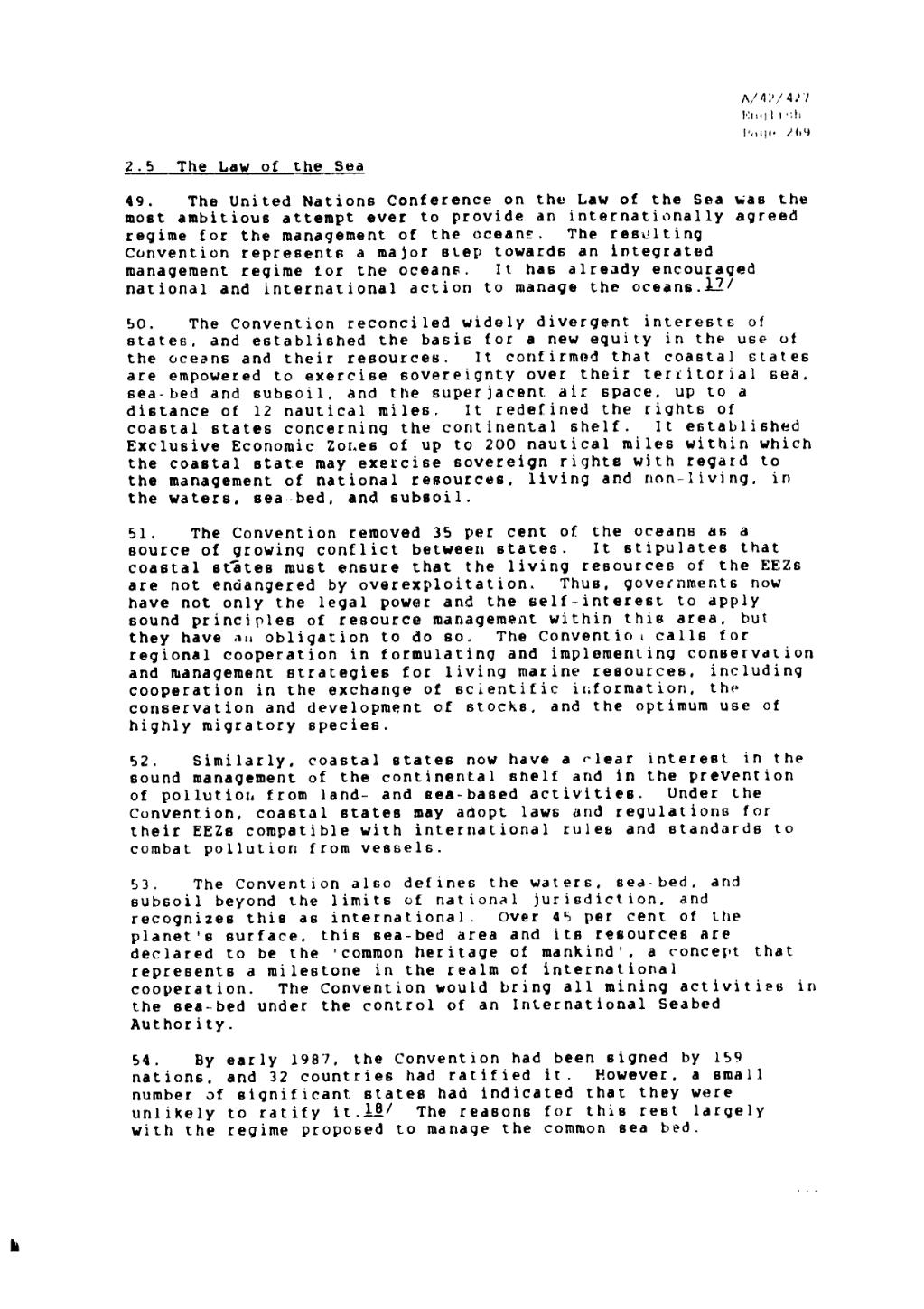A/42/427
English
Page 269
49. The United Nations Conference on the Law of the Sea was the most ambitious attempt ever to provide an internationally agreed regime for the management of the oceans. The resulting Convention represents a major step towards an integrated management regime for the oceans. It has already encouraged national and international action to manage the oceans.[1]
50. The Convention reconciled widely divergent interests of states, and established the basis for a new equity in the oceans and their resources. It confirmed that coastal states are empowered to exercise sovereignty over their territorial sea, sea-bed and subsoil, and the superjacent air space, up to a distance of 12 nautical miles, It redefined the rights coastal states concerning the continental shelf. I established Exclusive Economic Zones of up 200 nautical miles within which the coastal state may exercise sovereign rights with regard to the management of national resources, living and non-living, in the waters, sea-bed, and subsoil.
51. The Convention removed 35 per cent of the oceans as a source of growing conflict between states. It stipulates that coastal states must ensure that the living resources of the EEZs are not endangered by overexploitation. Thus, governments now have not only the legal power and the self-interest to apply sound principles of resource management within this area, but they have an obligation to do so. The Convention calls for regional cooperation in formulating and implementing conservation and management strategies for living marine resources, including cooperation in the exchange of scientific information, conservation and development of stocks, and the optimum use highly migratory species.
52. Similarly, coastal states now have a clear interest in the sound management of the continental self and in the prevention of pollution, from land- and sea-based activities. Under the Convention, coastal states may adopt laws and regulations for their EEZs compatible with international rules and standards to combat pollution from vessels.
53. The Convention also defines the waters, sea-bed, and subsoil beyond the limits of national jurisdiction, and recognizes this as international. Over 45 per cent of the planer's surface. this sea-bed area and its resources are declared to be he 'common heritage of mankind', a concept that represents a milestone in the realm of international cooperation. The Convention would bring all mining activities in the sea-bed under the control of an International Seabed Authority.
54. By early 1987, the Convention had been signed by nations, and 32 countries had ratified it. However, a small number of significant sates had indicated that they unlikely to ratify it.[2] The reasons for this rest largely with the regime proposed to manage the common sea bed.
- ↑ United Nations. Final Act of the Third Conference on the Law of the Sea. Montego Bay, Jamaica, December 1982. In its final form, the Convention is composed of 17 main parts (320 articles), dealing with the territorial sea and contiguous zone; straits used for international navigation; archipelago states: exclusive economic zone; continental shelf; high seas: regime of islands: enclosed or semi-enclosed seas: right of access of land-locked states to and from the sea and freedom of transit: the area. protection, and preservation of the marine environment: marine scientific research; development and transfer of marine technology: settlement of disputes: general provisions: and final provisions. There are nine annexes to the Convention: highly migratory species; Commission on the Limits of the Continental Shelf: basic conditions of prospecting: exploration and exploitation: statute of the International Tribunal for the Law of the Sea: Statute of the Enterprise; conciliations: arbitration and special arbitration and participation by international organizations. Under the Convention, coastal states may adopt laws and regulations in the EEZ compatible with international rules and standards to combat pollution from vessels.
- ↑ Among other things, declaration by the President of the United States, on 9 July 1982, and L.O.S. Bulletin, July 1985, issued by the Office of the Special Representative of the Secretary General for the Law of the Sea Convention.
